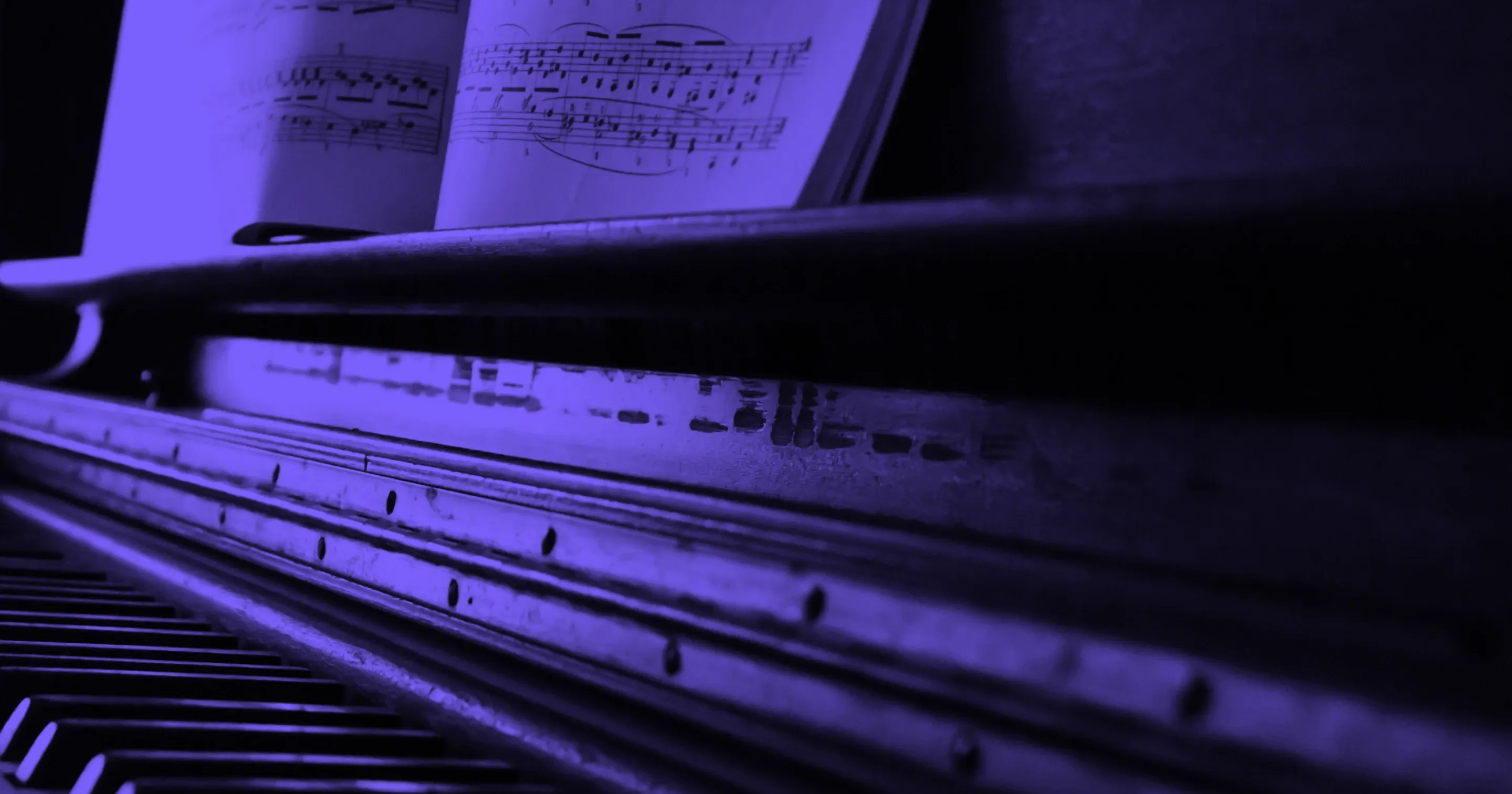
Learn the Chords in C Minor: A Music Theory Resource
Master the C Minor Key: Discover essential chords, useful progressions and techniques to elevate your music production and composing skills.
Introduction
A solid grasp of music theory is important for transforming your musical ideas into reality without having to test and try endless different chord combinations and melodic intervals. By mastering the core elements of harmony - like diatonic and chromatic chords and scale patterns - you enable your ability to create dynamic and engaging chord progressions with movement and intention.
In this article, we’ll explore the C minor key signature in depth. You’ll learn how to:
- Identify diatonic chords: Become familiar with the seven diatonic chords within the C minor key, and discover how to use them effectively to write expressive chord progressions.
- Leverage common progressions: By analyzing known songs in C minor you get practical applications on how chords are used to create tension, release, movement, and how they can take the progressions in unexpected directions.
- Incorporate modal interchange: Add depth and variety to your progressions with techniques such as secondary dominants, parallel chords, and modulating to the relative key signature.
By the end of this guide, you’ll have a stronger command of music theory fundamentals, empowering you to craft more sophisticated, expressive, and captivating music.
The Basics of C Minor
The three primary types of minor scales are the natural minor, harmonic minor, and melodic minor. Generally, when musicians refer to a"minor scale"they typically refer to the natural minor scale.
The C natural minor scale follows a specific sequence of whole and half steps, a pattern that characterizes the Aeolian mode.

Each note in a scale occupies a specific position, referred to as its scale degree. The scale degree defines the harmonic function and role within the key's chordal structure. The harmonic function of a note or chord depends on its relative level of tension to the tonic. Essentially, the scale degree determines the notes stability or instability within the key.
The notes and scale degree of C minor are:
- C – Tonic
- D – Supertonic
- Eb – Mediant
- F – Subdominant
- G – Dominant
- Ab – Submediant
- Bb – Leading Tone
To indicate a chord’s harmonic function and quality (major, minor, or diminished and augmented), Roman numerals are used:
- Uppercase Roman numerals represent major chords (III, VI, VII).
- Lowercase Roman numerals indicate minor chords (i, iv, v).
- A degree symbol (°) means diminished chords, and a plus sign (+) means augmented chord (ii°, vi+).
The specific Roman numeral assigned to a chord corresponds to its scale degree as well as reflecting the function within the key’s harmonic framework. Uppercase “V” means it’s a major dominant chord; Lowercase “vi” means a minor submediant chord, and so on.

The C Minor scale consists of seven naturally occurring notes, derived from the Aeolian mode's unique sequence of whole and half steps. Notes outside this scale are referred to as chromatic notes. These chromatic notes can introduce harmonic richness, unlocking non-diatonic chords which allows you to create more sophisticated progressions.
Chromatic notes serve multiple purposes: they can heighten tension, facilitate smooth transitions between key signatures, and modify the quality of diatonic chords to add variety and harmonic intrigue.
In the upcoming section, “Adding Complexity to C Minor Chords” we’ll explore techniques for incorporating chromatic notes to create more engaging and dynamic chord progressions.
Raised Seventh and the Major Dominant Chord
Raising the seventh scale degree is a common and powerful technique in minor keys. In C Minor, this means sharpening Bb to B♮(natural). This alteration changes the subtonic into a leading tone, which sits only a half-step below the tonic C. The result is a stronger, more compelling pull toward the tonic, creating a more decisive and satisfying resolution.
By raising the seventh scale degree we’re modulating to the harmonic minor.

Raising the seventh also changes the dominant chord from minor to major. In the key of C minor, this changes the dominant chord from G minor (G-Bb-D) to G major (G-B-D). This modulation gives us a chromatic chord because it incorporates the non-diatonic note B. The major dominant chord is widely used across various genres, as it heightens harmonic tension and provides a stronger resolution to the tonic. We’ll see practical examples of this later on in the article.
Accidentals
When we alternate diatonic notes they’re called accidentals:
- The sharp (♯) raises a note by a half step.
- The flat (b) lowers a note by a half step.
- The natural (♮) cancels previous alterations and restores a note to its original diatonic pitch of the key signature.
This ability to manipulate notes with accidentals allows composers, producers, and musicians to add harmonic interest and variety in the music by going beyond just the diatonic notes of the scale.
Chords in C Minor
i: C Minor
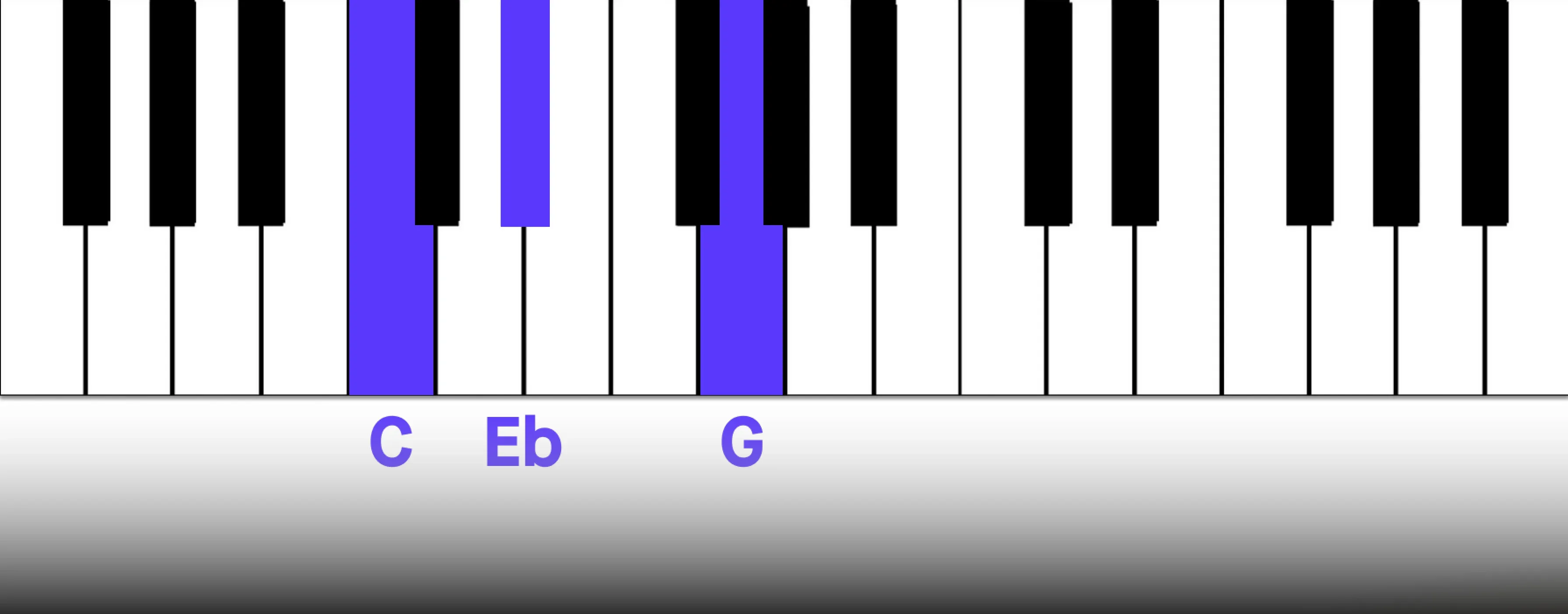
The tonic chord is the anchor of a scale and key signature, which provides a sense of stability and resolution. In chord progressions, returning to the tonic chord creates a feeling of finality and closure, much like bringing the music “home”. This resolution is fundamental to establishing the tonal center and giving listeners a satisfying and grounded conclusion.
ii°: D Diminished
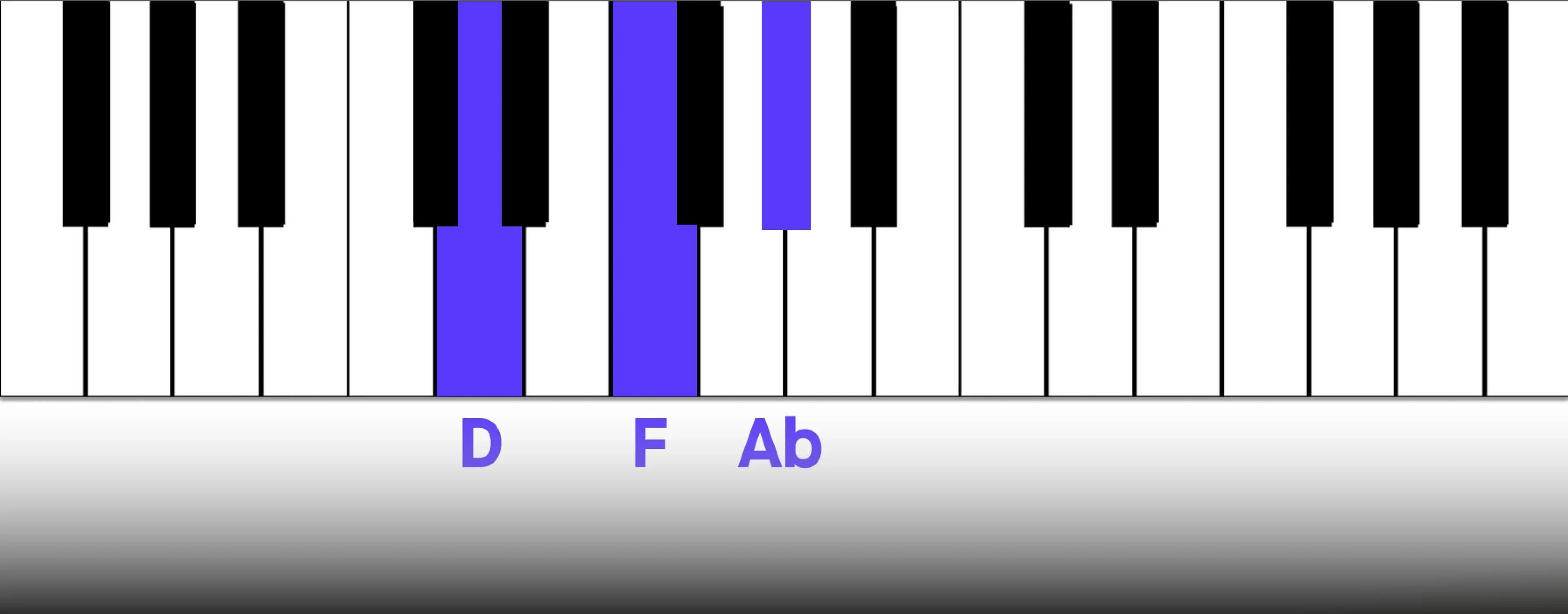
The diminished supertonic chord acts as a leading-tone chord, generating tension and naturally pulling toward resolution on the tonic chord. Both the supertonic and dominant chords play key roles in creating harmonic instability, which moves the progression forward and heightens the eventual sense of stability achieved with the tonic resolution.
A natural minor ii chord (non-diminished) has more of a subdominant function, meaning it often tends to move to the dominant chord.
III: Eb Major
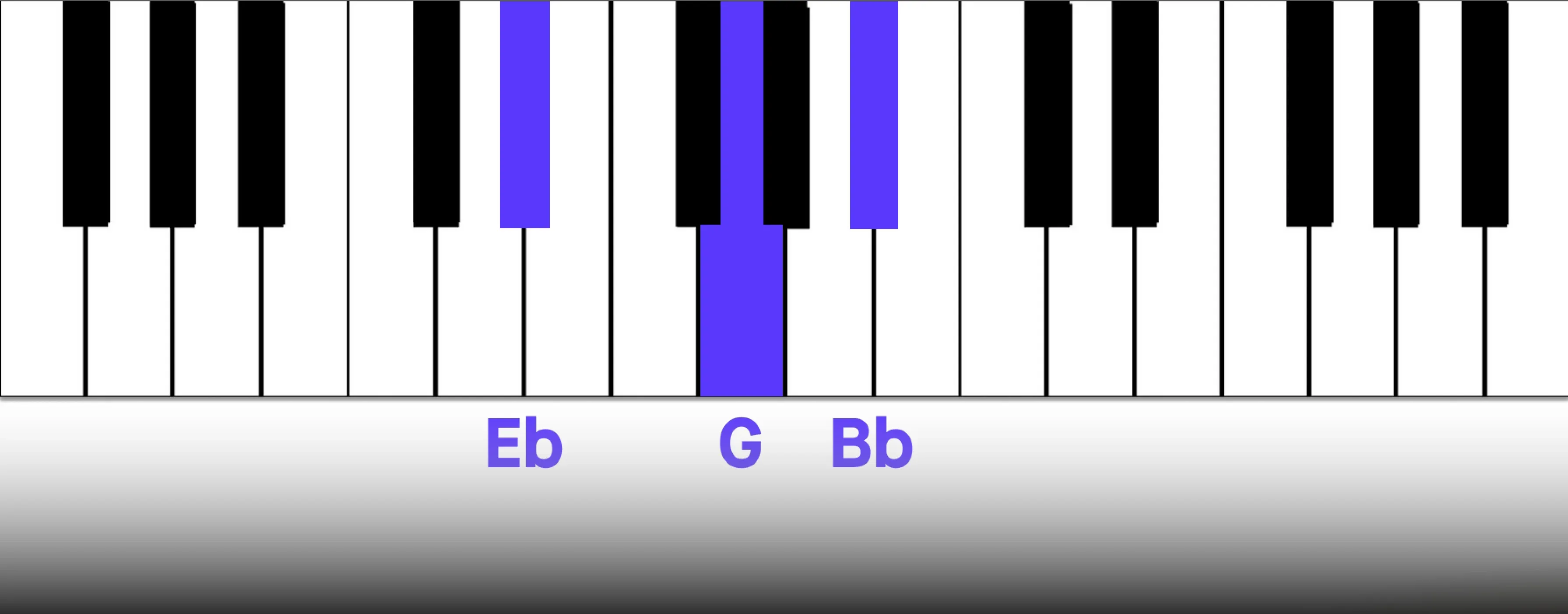
The tonic and mediant chords share two common tones and therefore a similar tonal center. However, they still differ in their harmonic qualities - one being major and the other minor - which makes for an interesting interval between the two chords. Because of the shared tonal foundation, the mediant chord also functions as a substitute for the tonic chord, which can add expression and dynamics to your chord progressions.
By strategically replacing the tonic with the mediant, particularly in verses or less climactic sections, you can enhance the impact of the tonic when it reappears during key moments like choruses or cadences. Beyond the added variety, this helps you avoid predictable harmonic resolutions and movements. Additionally, the mediant scale degree in a minor key aligns with the key signature of the relative major key, making it a great chord choice for modulation to the relative key. We’ll explore this concept in greater detail later.
iv: F Minor
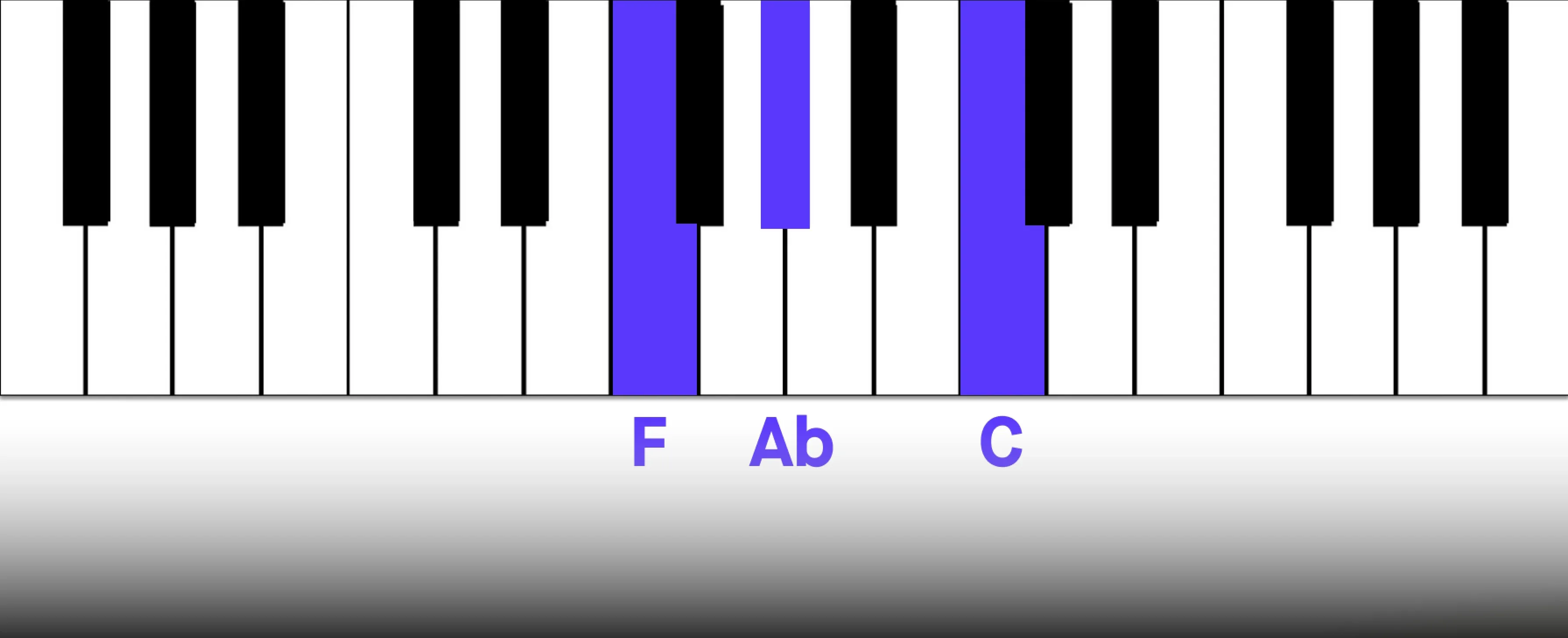
The subdominant chord is a versatile chord with many useful functions. It offers both contrast and anticipation - particularly in the i–iv progression. It ccan also be used to conclude musical phrases in a satisfying way.
Furthermore, its natural resolution to the dominant chord builds tension and propels the music forward. At the same time moving to the minor vi chord offers a smooth and satisfying harmonic shift.
v/ V: G Minor/ G Major
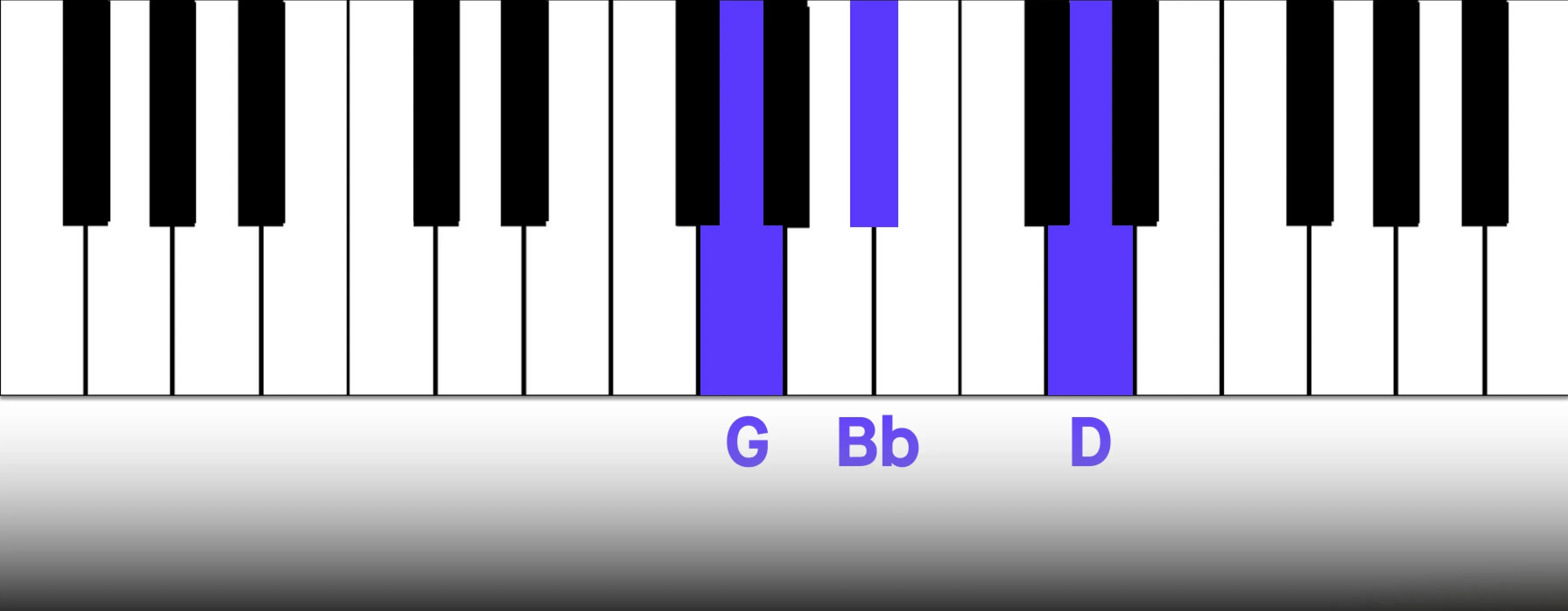
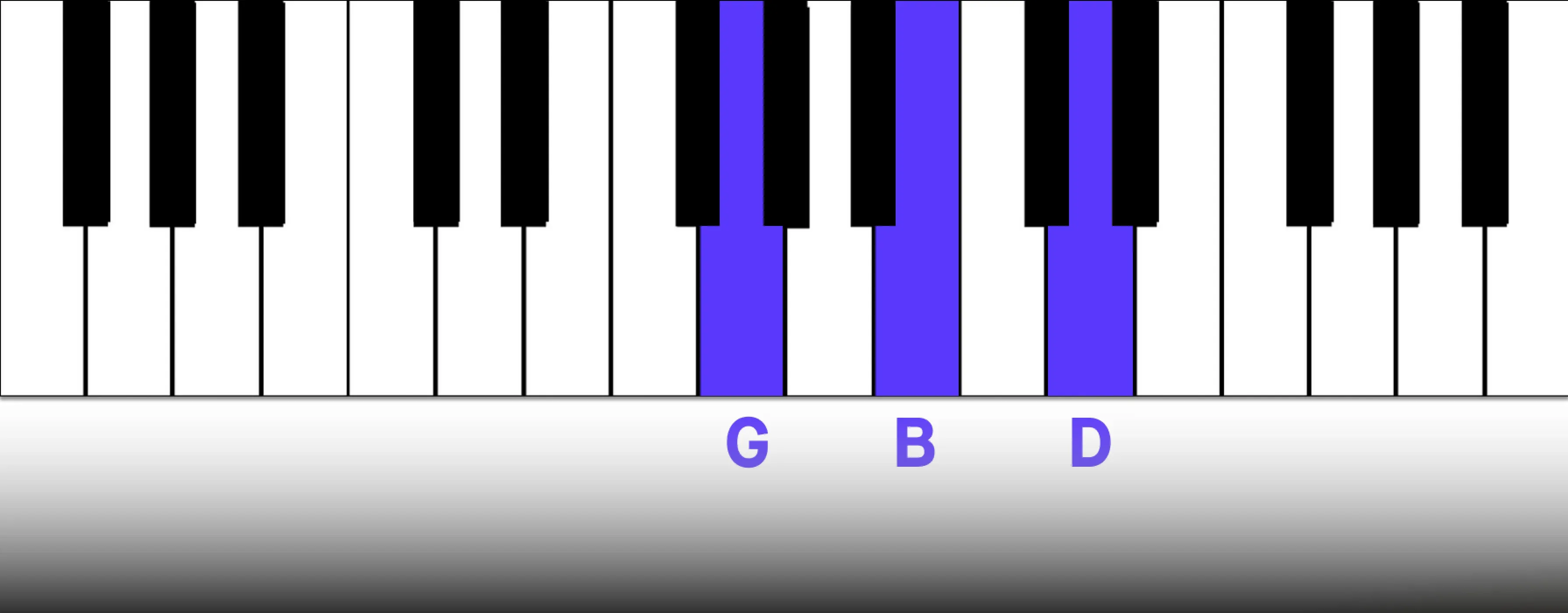
The dominant chord, with its inherent dissonance - particularly as a major chord - creates a strong, natural pull toward the tonic, driving resolution and closure. Introducing a seventh to the dominant chord further amplifies this tension, making the eventual resolution even more impactful.
In some cases, chord progressions may begin on the dominant, which immediately establishes a sense of energy and anticipation. This approach can create a striking contrast with the preceding section and sets the stage for a dynamic harmonic journey. Choruses starting on the dominant can be a powerful tool to differentiate it from verses and give it more energy.
VI: Ab Major
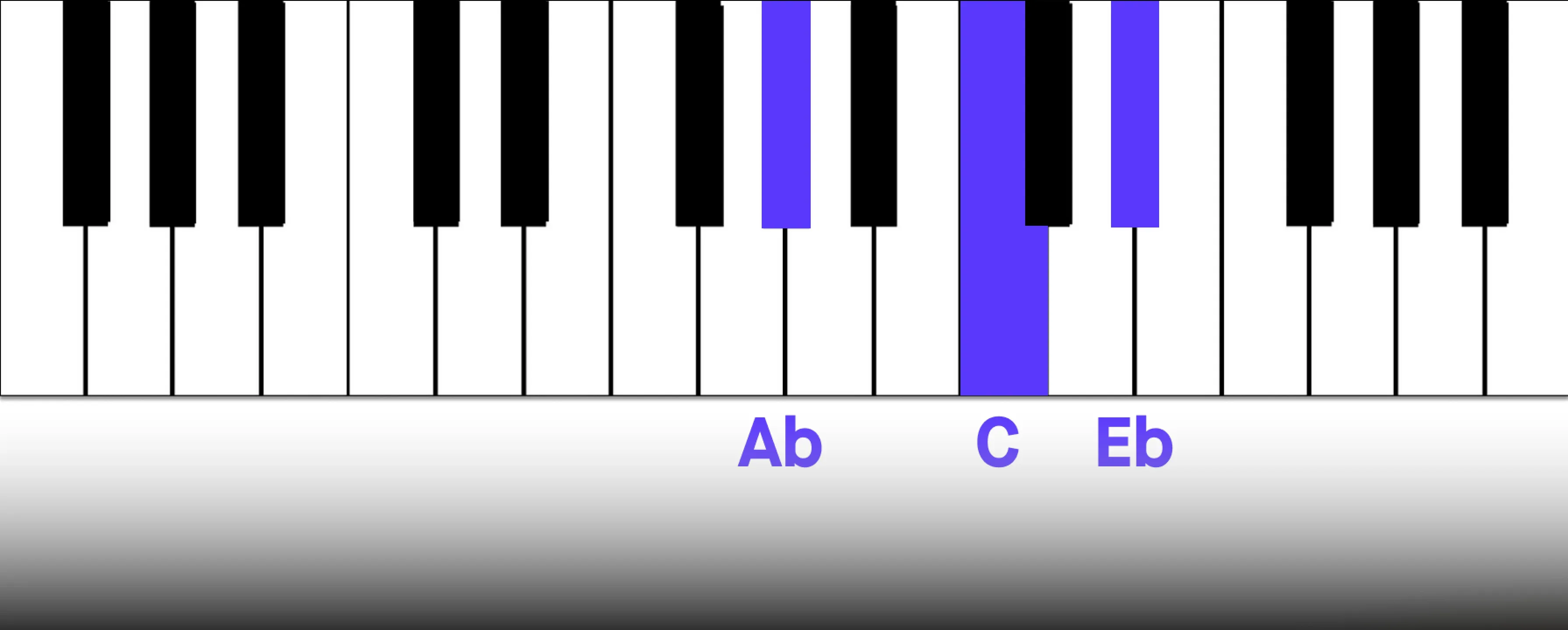
The submediant chord can offer a sense of temporary resolution that’s different from what the tonic provides. Since the third of the major VI chord is the root of the tonic chord it can effectively serve as a tonic substitute. It provides a stable harmonic foundation while introducing variety to the progression.
VII: Bb Major
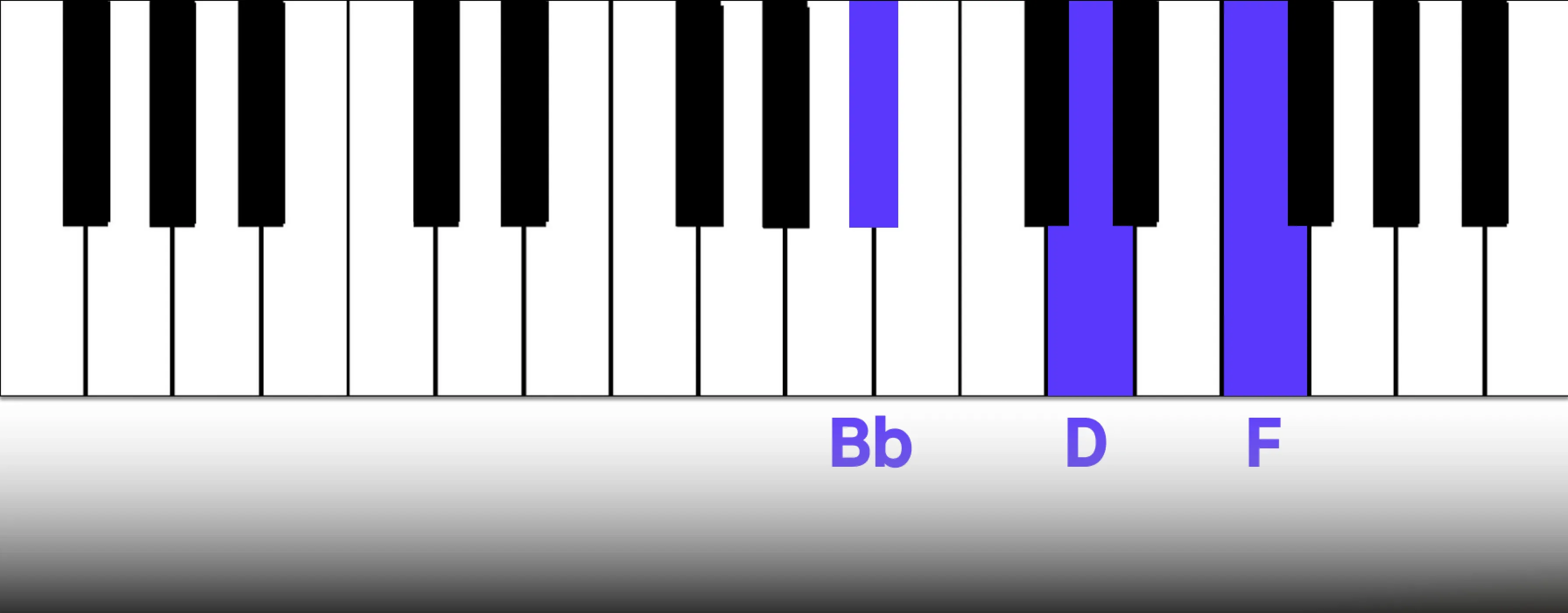
The chord built on the seventh scale degree offers a wide range of harmonic possibilities. As a subtonic, it provides a smooth, natural resolution to the tonic chord. In modern pop and rock music the VII chord is frequently used. In more traditional settings it’s often used as a passing chord moving in a descending or ascending direction towards the dominant or tonic. Passing chords help connect phrases and create a seamless flow in any chord progression.
A more advanced perspective on the VII chord is to interpret it as a secondary dominant of the relative major key (Eb). With the help of the VII chord, we can modulate to the relative key with ease, without a strong sense of harmonic interruption. Secondary dominant chords borrow V-I intervals from a different key, which is why they’re particularly useful. We'll explore secondary dominants in more detail later in the article.
Primary and Secondary Chords in C Minor
In C minor, diatonic chords are divided into primary and secondary categories.
- The primary chords: i, iv, and v/V serve as the core harmonic foundation of the key, providing stability and structure.
- The secondary chords: ii°, III, VI, and VII introduce harmonic color and complexity, adding depth to chord progressions.
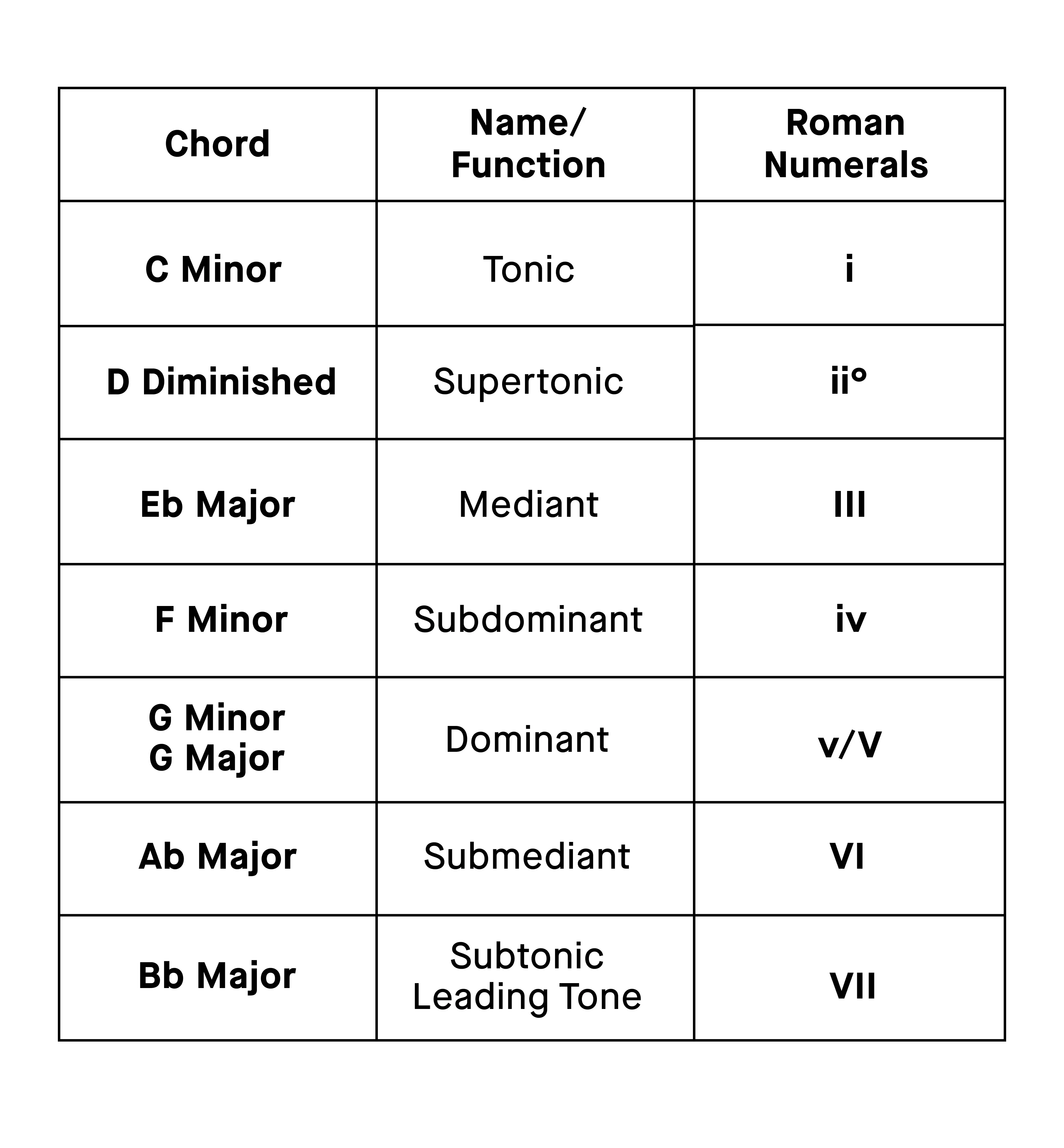
Understanding Chord Relationships and Intervals
To truly grasp and understand chord relationships and intervals, experiment with different chord combinations. Begin with the tonic chord and explore the intervals of each diatonic chord in the key. Additionally, try working with chord inversions to see how they influence the sound and stability of each chord.
This hands-on approach will expand your musical vocabulary, allowing you to instinctively choose the right chord and inversion to create the sound you hear in your head. Rather than testing every possible chord combination, you'll develop a more intuitive sense of harmonic possibilities, knowing which chord you're seeking as you write music.
To further improve your interval recognition skills, associate intervals with familiar songs. For a helpful guide, check out our article on Ear Training, which provides a list of songs that highlight each interval, both ascending and descending.
Cadences in C Minor chord progressions
Cadences are musical"punctuations"that mark the end of phrases or sections, guiding the listener through the structure of the song. A proper use of cadences is essential for creating natural dynamics, movement, development, and overall musical interest. Just as we use punctuation in language—such as exclamation points, question marks, or pauses mid-sentence to convey meaning, cadences in music serve a similar purpose.
Strategically placing cadences enhances the emotional depth of your music. For example, reserving the strongest cadences for pivotal moments can amplify their impact and heighten the music’s emotional resonance.
In the following section, we will explore the common cadences in C minor and their role in shaping musical expression.
Perfect Cadence
Dominant → Tonic (V - i)
G → Cm
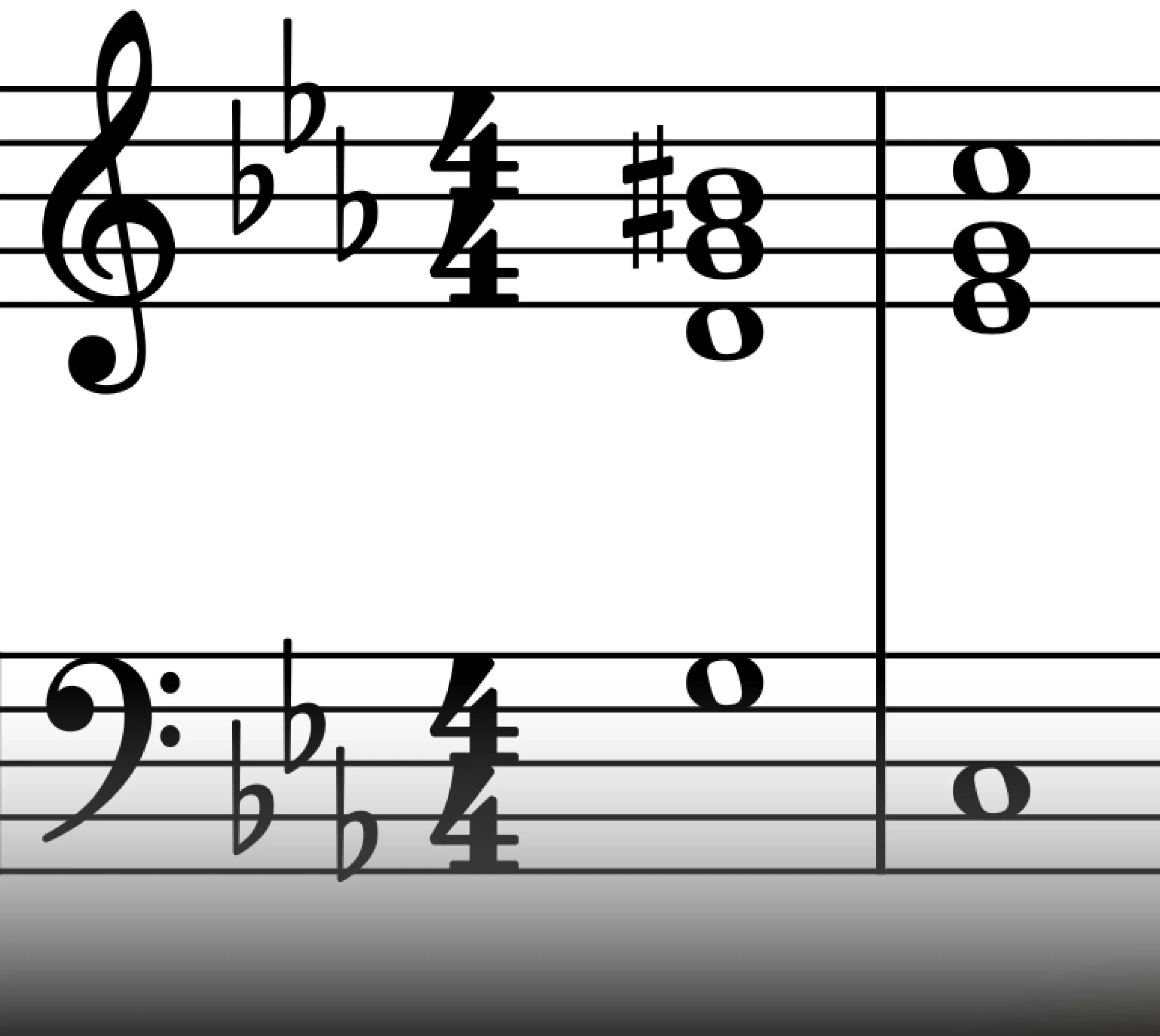
The perfect cadence, an interval from the dominant to the tonic chord, is the most definitive and forceful cadence, providing a clear sense of resolution and musical closure. This cadence is often used to conclude a piece of music. To further enhance its impact, introducing a dominant seventh chord before the tonic can intensify the final resolution, making it even more powerful and conclusive.
G7 → Cm (V7 - i)
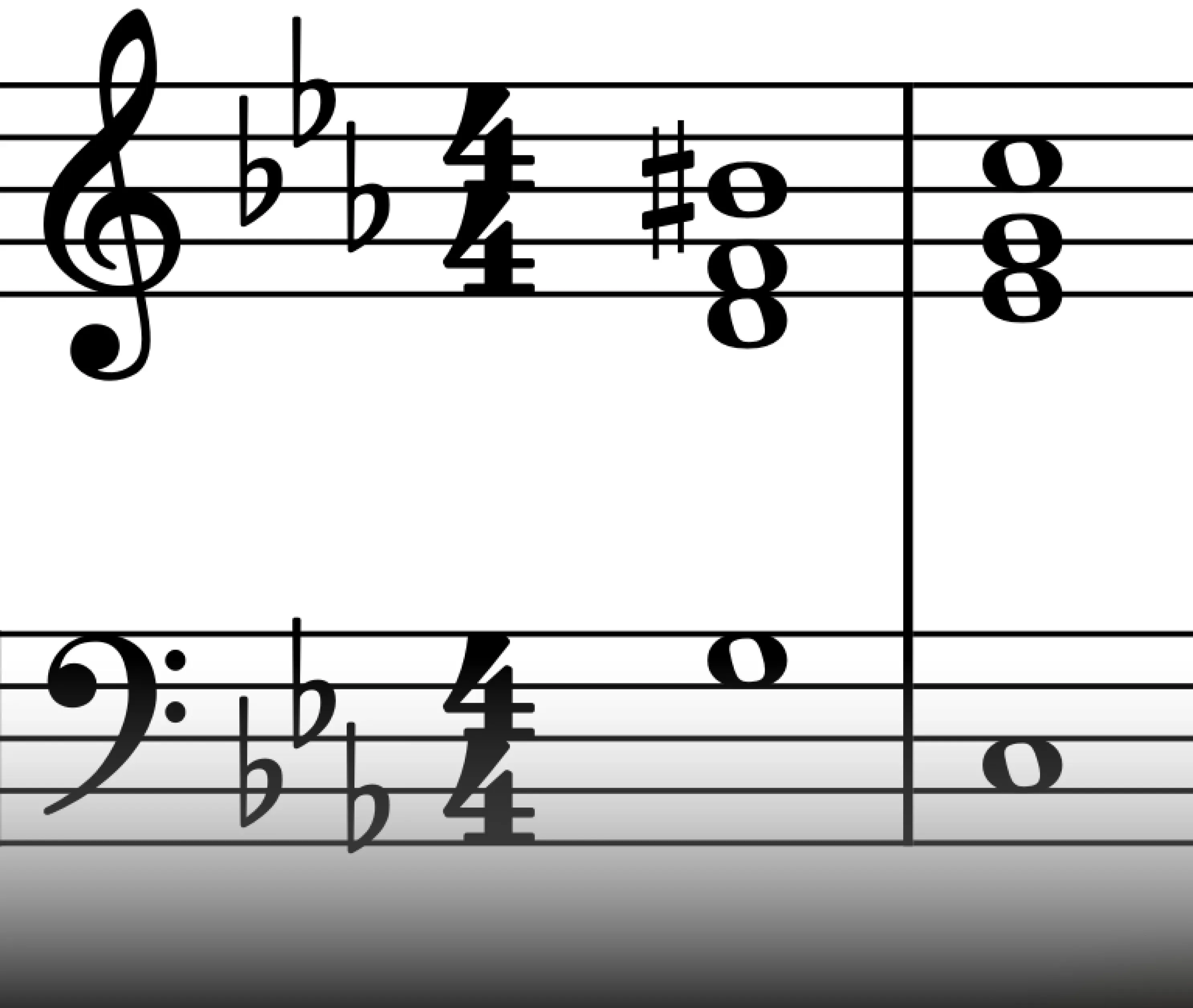
A perfect cadence requires two key conditions: both chords must be in root position, and the highest voice of the final chord must be the root note. When these conditions are met, the resolution is at its most powerful, creating a strong and satisfying sense of closure.
Plagal Cadence
Subdominant → Tonic (IV - i)
F → Cm
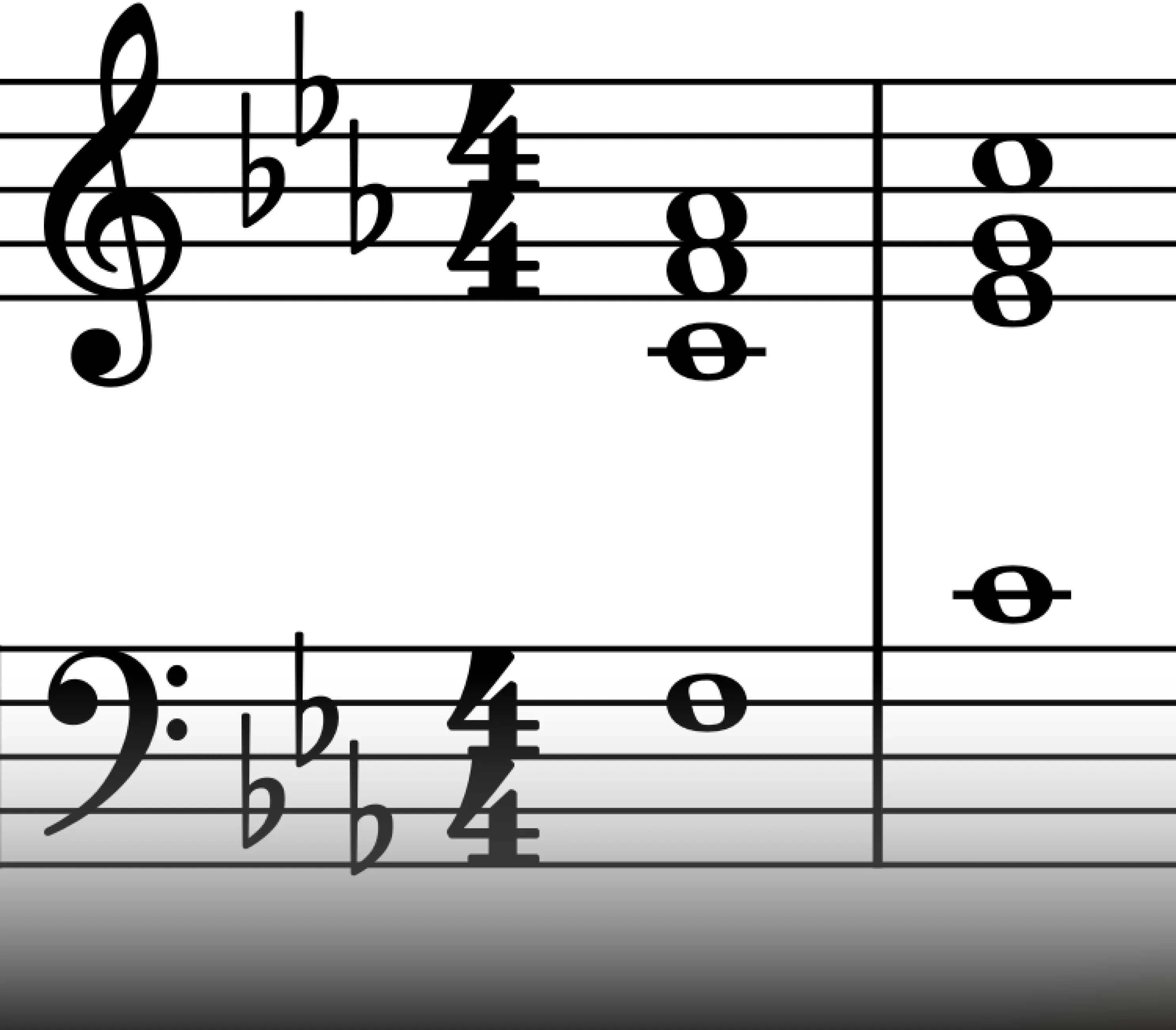
The plagal cadence, often referred to as the"Amen Cadence,"offers a gentler, more subdued resolution compared to the perfect cadence. This cadence is frequently heard in traditional hymns, typically accompanying the final word"Amen,"which is why it has earned its nickname.
Half Cadence
Tonic, or Supertonic, or Subdominant → Dominant: (i / ii / iv → V)
Cm→ G
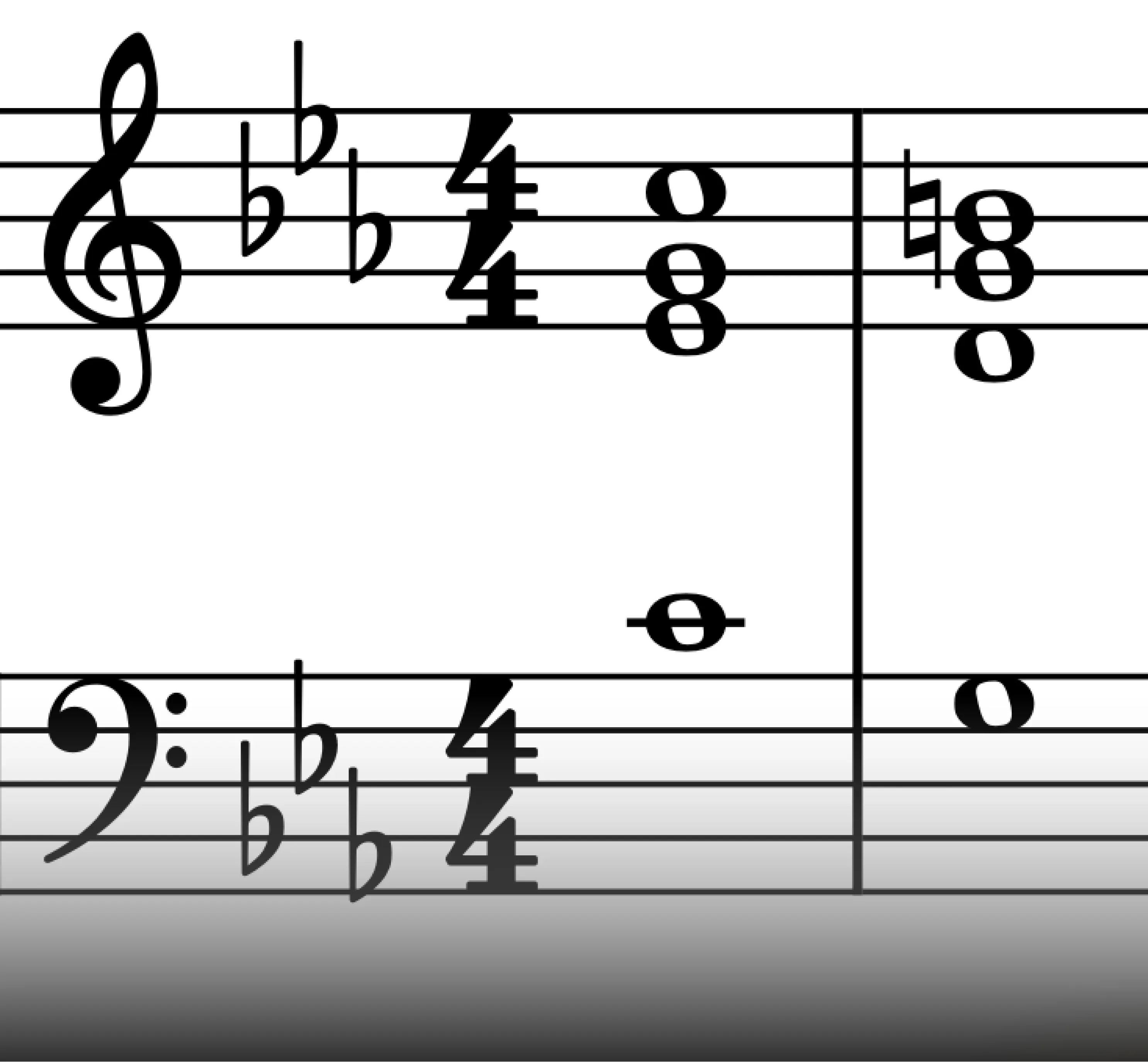
D° → G
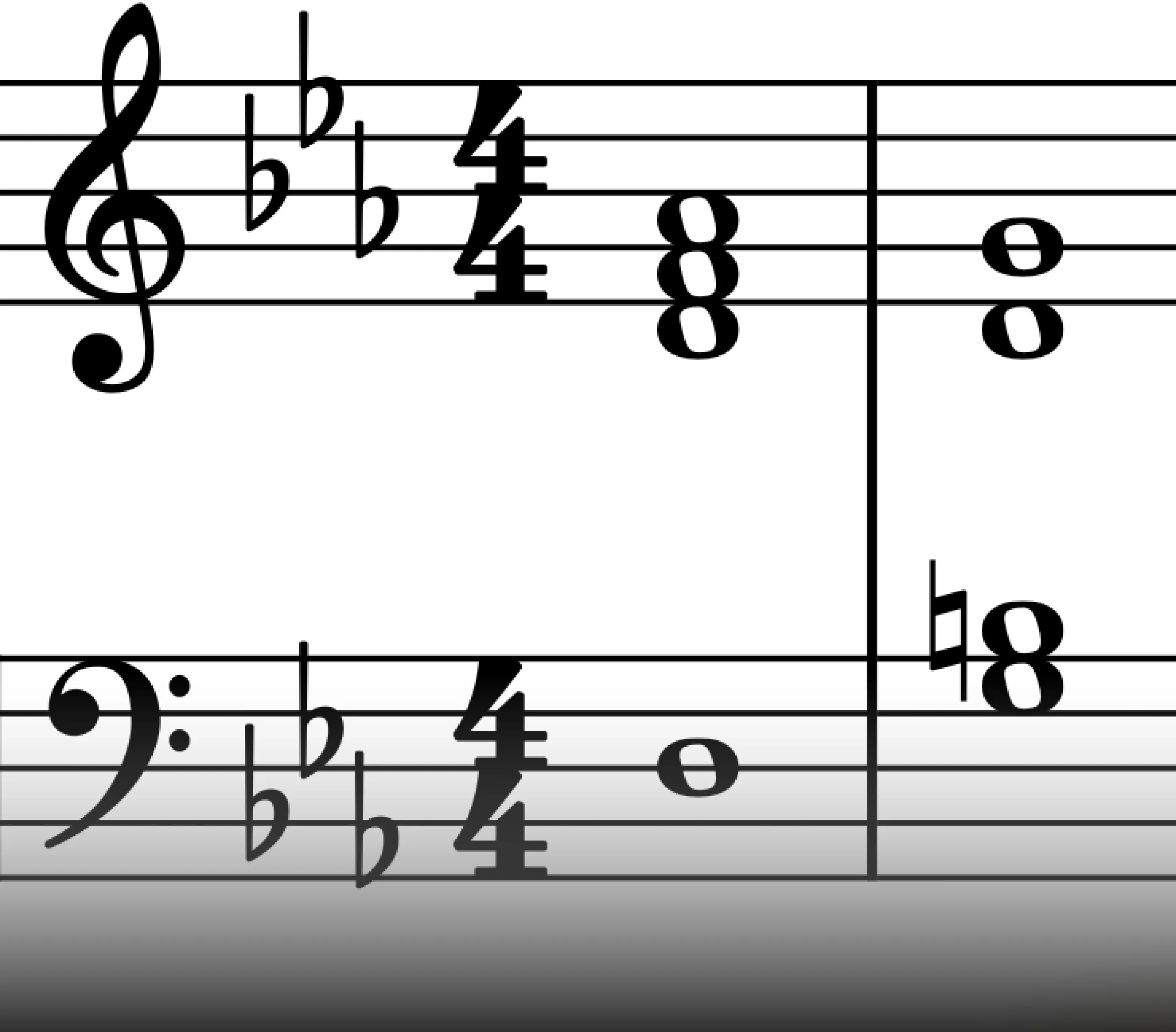
Fm→ G
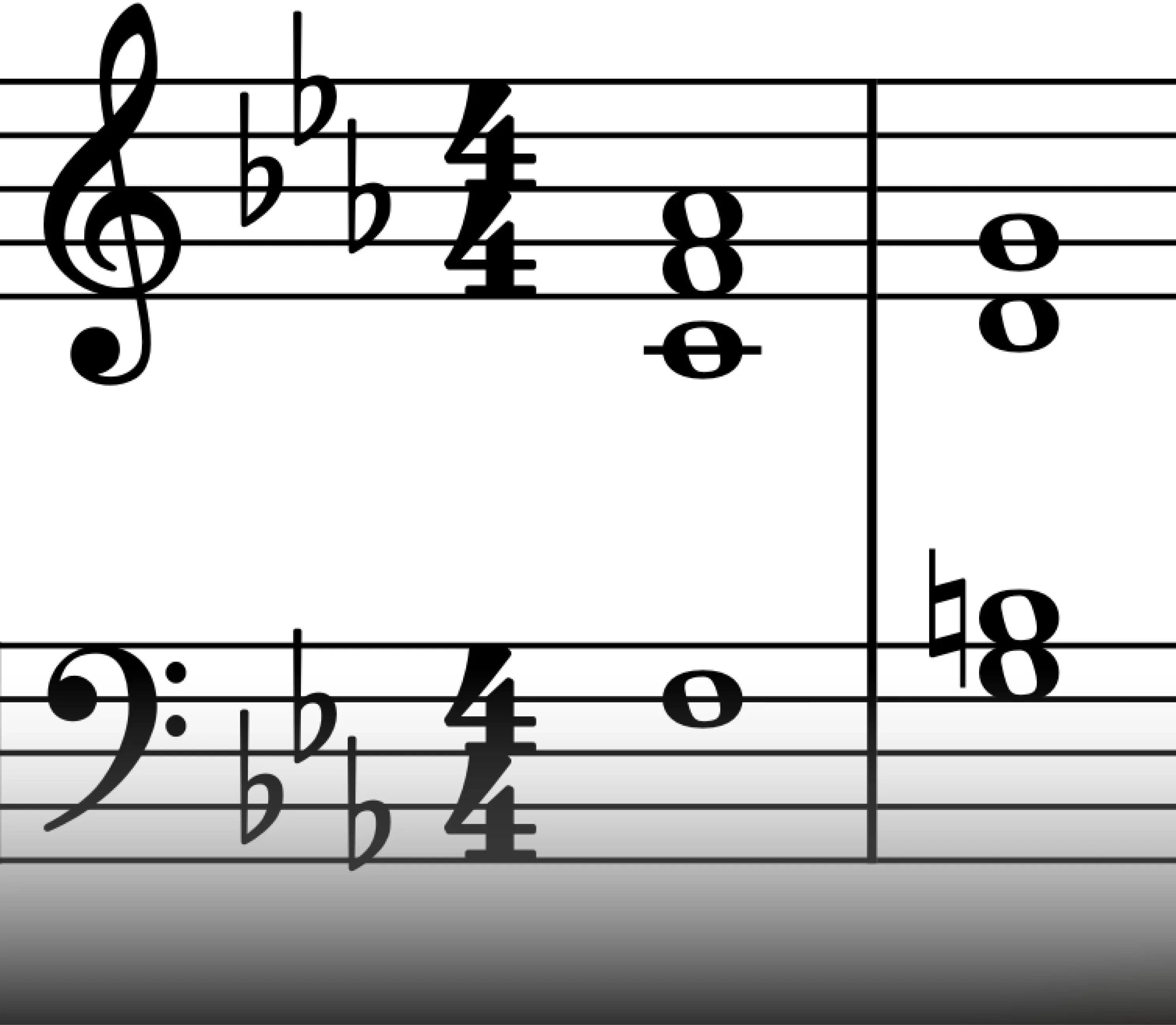
A half cadence ends a phrase on the dominant chord, leaving the progression feeling unresolved since it ends on the most tension-filled chord in the key. Unlike the definitive closure provided by perfect or plagal cadences, the dominant’s inherent instability creates a feeling of incompleteness.
By strategically using half cadences, you can play with listener expectations, building suspense and introducing a sense of musical ambiguity. For example, ending a bridge or pre-chorus on a dominant chord sets up a powerful and explosive start of the next section that begins on the tonic chord. This technique enhances the dynamic flow and emotional impact of your music, which keeps the listener engaged and anticipating what comes next.
Interrupted Cadence
Dominant to Submediant (V - VI)
G → Ab
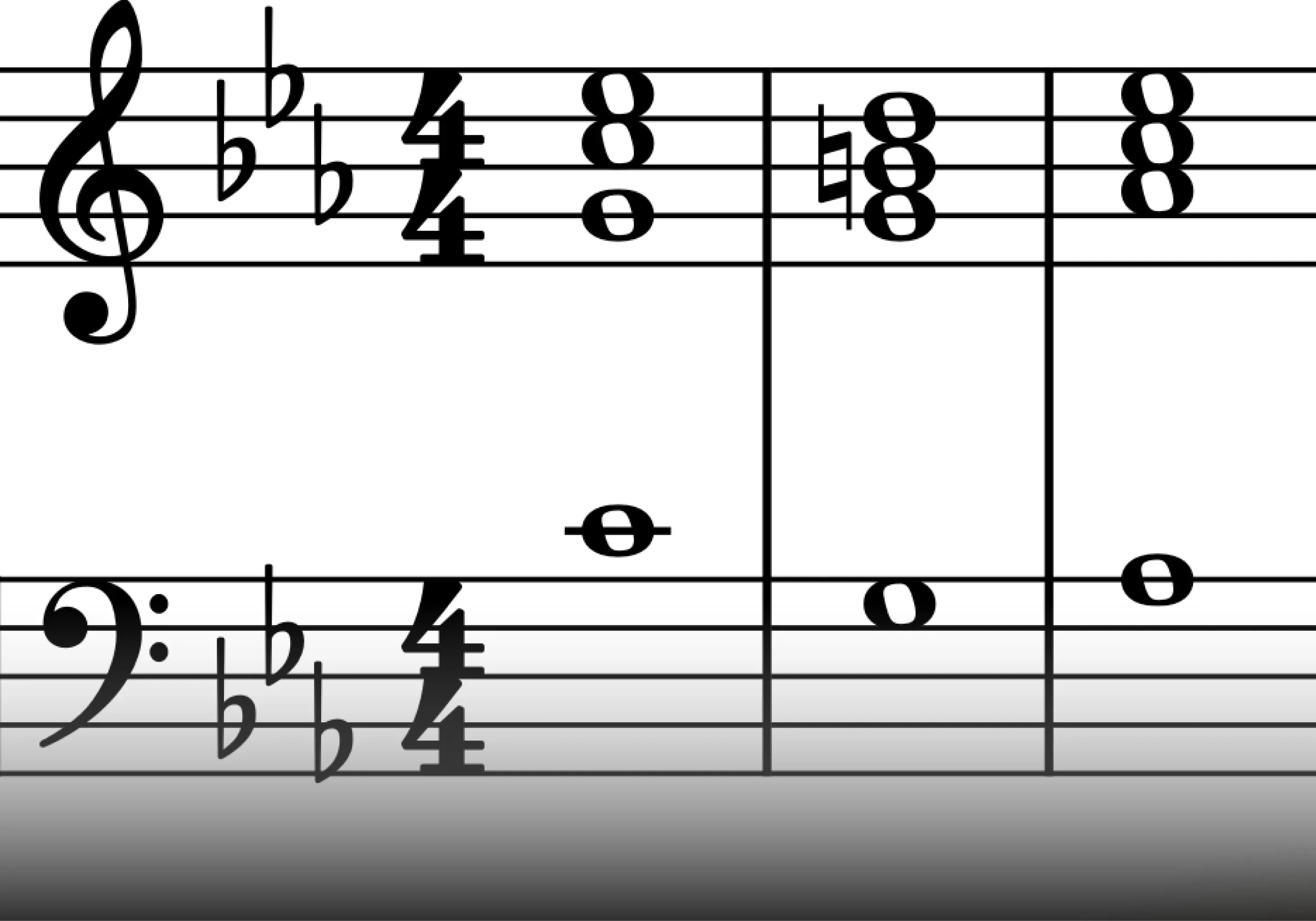
An interrupted cadence generally hints at the expected strong resolution, like a perfect cadence, only to take an unexpected turn and resolve to the submediant chord instead. This surprising shift provides a sense of musical surprise.
Common Chord Progressions in C Minor
In this section, we’ll explore several interesting chord progressions in C minor found in well-known songs. Among several things, we'll look at the strategic use of mediant and submediant chords as tonic substitutions, as well as delve into the subtleties of various harmonic techniques - such as using parallel chords, which we’ll delve into deeper later in the article. Now, let’s dive into some common chord progressions in C minor.
i (Cm)- III (Eb) - VI (Ab) - Vsus4 (Gsus4) - V (G)
This simple yet harmonically rich chord progression is the foundation of Gnarles Barkely’s “Crazy”. C Minor has a dark and haunting quality to it. By using both the mediant and submediant, the progression introduces a prominent contrast between major and minor, adding emotional depth and a sense of ambiguity. Furthermore, the use of a suspended dominant creates a harmonic “pause”. Since suspended chords are neither major or minor, they’re building anticipation before resolving to the next chords, In this case, it moves to the major dominant. This final chord, with its raised leading tone, delivers a powerful pullback to the tonic.
i (Cm) - VI (Ab) - IV (F) - iv (Fm)
The chord progression in the verse in Adele’s “Skyfall” is both captivating, harmonically rich, and has a suspenseful quality. A standout feature is the use of the major IV chord, a non-diatonic element that adds an unexpected harmonic twist and contributes to the classic James Bond sound.
The interval between Cm and Ab major involves the dominant note G rising chromatically to Ab. This is followed by another chromatic step when the progression shifts to the non-diatonic F major chord. Moving the third back down to Ab gives us the Fm chord. This chromatic movement is a hallmark of the James Bond theme and it builds tension and anticipation, giving the progression a sense of forward motion, intrigue, and suspens.
As the verse comes to an end, the chord progression is i - Vsus4 - V heightens the harmonic suspense. The suspended dominant is particularly important as it prolongs the anticipation. The eventual shift to the major dominant allows for a peak moment of tension, making the return to the tonic in the chorus feel even more powerful and cinematic.
VI (Ab) - VII (Bb) - i (Cm)
Here is a simple chord progression using only three chords. Perhaps the most notable aspect of it is the lack of a dominant chord. Omitting the dominant is common in pop music that aims to create a “floating” quality. It lacks a clear start and end, which makes it ideal for looping or playing the chords repeatedly over a longer period of time.
Coldplay uses this exact progression in “Hymn for the Weekend”, giving the song an ambient and almost endless feel.
The chords also move in a stepwise motion, which adds momentum and a hopeful quality to the music. Lastly, the two major chords within a minor key prevent the song from feeling too somber. However, the C Minor chord introduces a sense of melancholy and longing, adding emotional depth to the progression.
i (Cm) - V (G/B) - III (Eb/Bb) - IV (F/A)
Christina Perri’s hit"Jar of Hearts"modulates between C minor and Eb major, reflecting the contrasting themes of mournfulness and hope in the lyrics. This chord progression is from the bridge, which is in C minor, and carries a particularly haunting harmonic quality. It makes use of chord inversions and a chromatic F major chord to create a stepwise descending bass line.
The bass line moves through the notes C, B, Bb, and A (from the chromatic F major chord). In the final repetition of this pattern, Perri adds a twist by extending the progression with an extra measure, playing Ab major, followed by G major.
This extension further deepens the descending bass line, heightening the sense of tension that peaks with the dominant G major chord.
The use of inversions and chromatic movement enriches the song's emotional depth, creating an atmosphere that is both haunting and dynamic, while introducing harmonic surprises that keep the listener engaged.
iv (Fm)- VI (Ab) - i (Cm) - III (Eb)
“Enjoy the Silence” by Depache Mode has an interesting chord progression. The chorus begins on the subdominant chord, immediately establishing a sense of anticipation. This tension is then partially relieved when it moves to the submediant chord, which offers a sense of stability but avoids a definitive resolution to keep the progression from feeling complete.
The progression then resolves to C minor, bringing the listener home to the tonic chord. After that, it moves to the mediant, which adds a layer of color to the harmony while providing a sense of variety within the same tonal center without completely departing from the tonic key.
One of the most compelling aspects of this progression is the momentum created through the interplay of alternating major and minor chords. The shifts in quality evoke both tension and release.
Let’s look at one more interesting example from the same song.
i (Cm) - iii (Ebm) - VI (Ab)
In the verse of Depeche Mode’s"Enjoy the Silence", the song utilizes a chromatic mediant chord interval, moving from the tonic chord to the minor iii. This is called a chromatic mediant because the diatonic G is lowered by one-half step to Gb - a chromatic note. This creates an unexpected harmonic shift.
This technique is highly effective in creating a sense of uncertainty and ambiguity. While chromatic mediant progressions are commonly used in film, TV, and video game scores, they are relatively rare in pop music. As a result, Depache Mode’s use in this context feels particularly surprising and striking. The chromatic mediant shift introduces an emotional shift that feels unfamiliar, adding an element of tension or unexpected depth that enhances the overall mood of the song.
For more information about chromatic mediants and other dark-quality techniques, check out our article on Dark Chord Progressions.
Playing Chords Outside of the Key Signature
The Aeolian mode provides the foundation for the natural minor scale, but incorporating chromatic notes allows us to greatly expand our harmonic possibilities, resulting in more dynamic and compelling chord progressions.
Chromatic notes are essential for building diminished and augmented chords, and by weaving them into our progressions, we can alter the quality of diatonic chords, enriching the overall harmonic palette and thus giving us access to play notes and chords outside the original key signature.
Another effective way to introduce harmonic variety is by modulating to the relative key, offering a fresh tonal perspective and further enhancing the music's complexity and interest.
Relative Major: Eb Major
Every major key has a corresponding minor key, and vice versa. These key pairs share the same notes but differ in their tonal centers and chord functions.
- The relative major: In a minor scale, the relative major is found on the third scale degree, the mediant. In C minor, that’s Eb major.
- The relative minor: The relative minor is found on the sixth scale degree, the submediant. In Eb Major, that’s C minor.
In a minor scale, the relative major is found on the third scale degree, the mediant. In C minor, that’s Eb major.
The relative minor is found on the sixth scale degree, the submediant. In Eb Major, that’s C minor.
Modulating Between Relative Keys
Modulating to Eb major opens up a new tonal landscape with seven distinct diatonic chord functions, all within the same key signature. The close relationship between C minor and Eb major offers exciting harmonic possibilities. This subtle tonal shift can add depth to a composition, creating contrasting emotional qualities for different sections of a song.
Modulating between relative keys is a powerful technique to keep a song from becoming stagnant. For example, transitioning from C minor to its relative major Eb major can add a sense of energy and uplifting feeling. On the other hand, moving to the parallel minor can evoke a more melancholic, introspective mood.
Adding Complexity to C Minor Chord Progressions
There are several effective ways to add harmonic interest to a song without fully modulating to a different key or shifting the tonal center. In this section, we’ll focus on parallel chords and secondary dominants - two techniques that can introduce dynamic shifts and harmonic variations while maintaining the overall tonality of the piece.
Parallel Chords
Parallel chords are created by altering the quality of a chord using accidentals. This adds unexpected harmonic twists. For example, sharpening the third of the subdominant chord from Ab to A gives us F major, which evokes a different emotional color compared to the diatonic minor subdominant chord. Additionally, occasionally using the opposite quality for the tonic chord can introduce surprising emotional shifts within a phrase or section, adding further depth to the music.
However, it’s important to use parallel chords sparingly. Overuse can weaken the music’s sense of direction, as it risks losing a clear tonal center. When employed strategically, these chords guide the listener through unexpected harmonic journeys while preserving the overall tonal cohesion of the song.
Secondary Dominants
A secondary dominant is a dominant chord borrowed from a key other than the main key of the song. It’s a powerful tool for creating harmonic tension and resolution, adding depth and complexity to chord progressions and making them more engaging.
A common type of secondary dominant is built on the fifth scale degree of the primary dominant chord. This is called the"dominant of the dominant"(V/V). This involves treating the primary dominant as a temporary tonic and preceding it with its own dominant chord.
In C minor, the dominant chord is G major, and the dominant of G major is D major. By playing the chromatic D Major chord before the primary dominant, we create a V-I interval from the G major scale (since G is now our temporary tonic). Here’s an example of how this works:
i (Cm) - V/V (D7) - V (G7) - i (Cm)
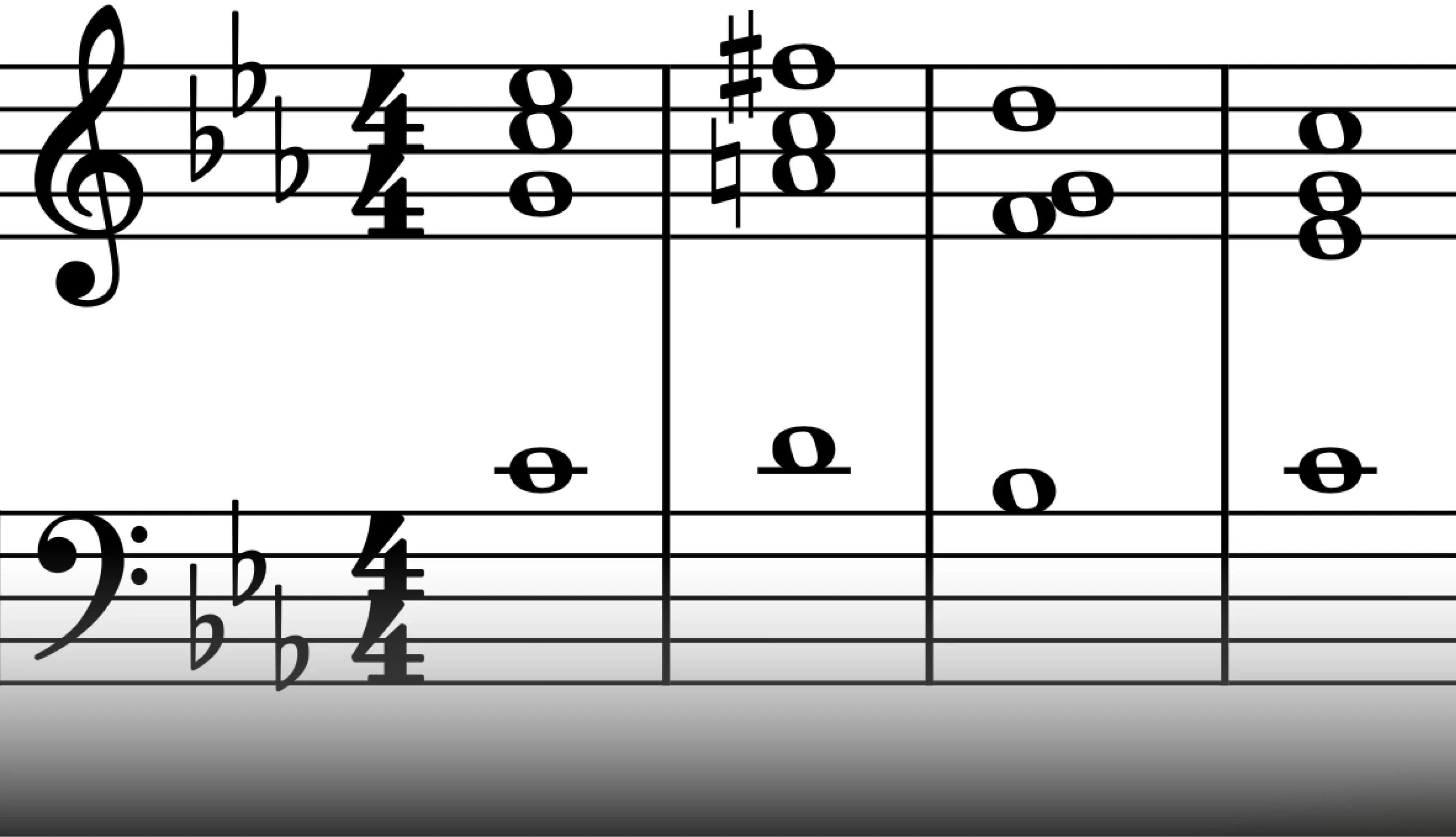
A solid understanding of key music theory concepts can quickly and significantly enhance your music production, composition, or songwriting abilities. By grasping the relationships between chords and notes, you'll be equipped to create music that is more purposeful, emotionally resonant, and compelling.
How Musiversal Can Help You Write the Best Music
A strong understanding of music theory is invaluable when collaborating with Musiversal's talented musicians. It allows you to clearly communicate your musical vision, ensuring your ideas are effectively translated into the final product.
For instance, including a V/ii in your chord chart indicates the use of a secondary dominant, helping musicians make informed voice-leading decisions and smoothly connect the chords.
If you need guidance in crafting compelling chord progressions or adding harmonic depth to your music, our pre-production and songwriting experts are ready to assist.
With a Musiversal Unlimited subscription, you get unlimited access to a roster of over 80+ professional musicians and engineers. Together, you can bring your musical dreams to life.
Your Music, No Limits.
Join the Waitlist